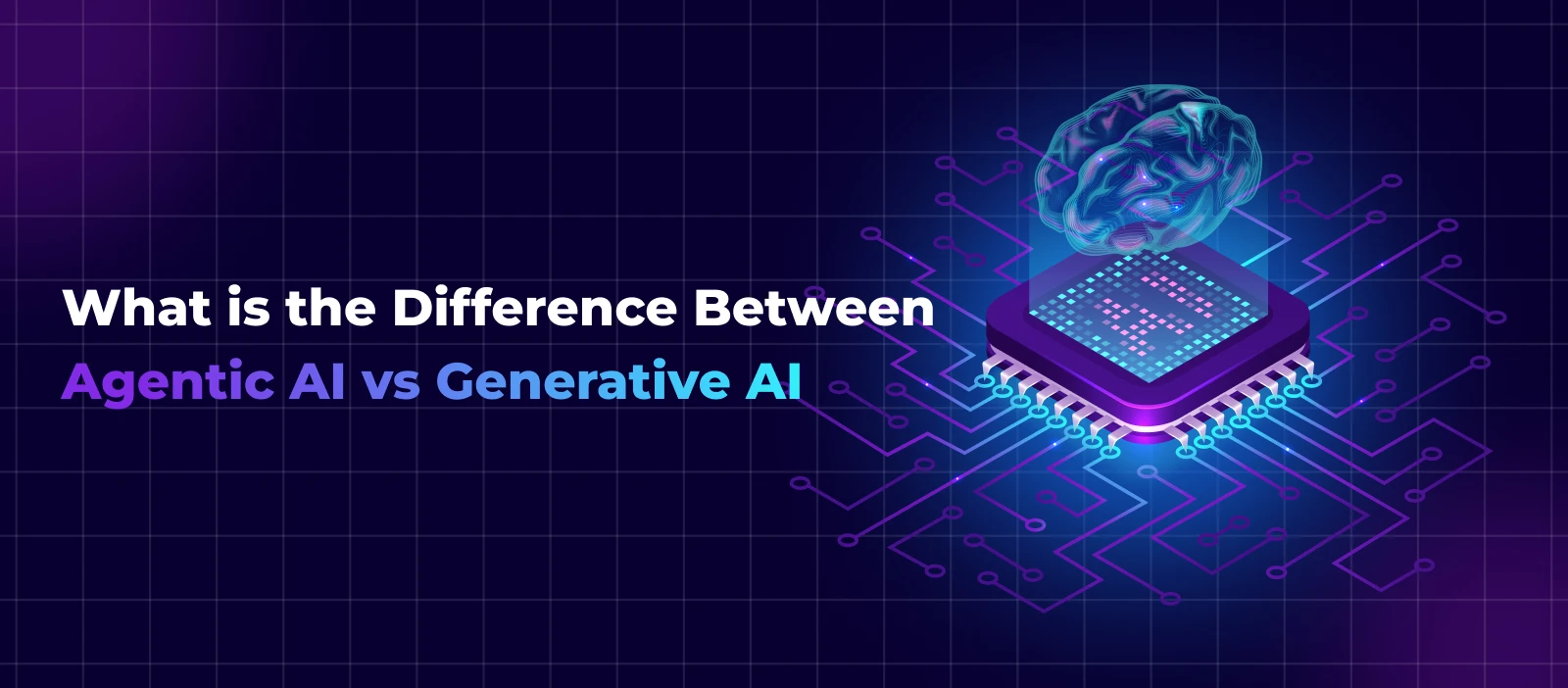What is the difference between Agentic AI Vs Generative AI?
September 10, 2025

Agentic AI and Generative AI are two forceful currents of artificial intelligence. Both are cutting-edge, yet each has its own function. Agentic AI is centered on autonomy. It is able to plan, act, and make decisions in order to achieve tasks. Imagine it as a wise assistant that acts towards objectives without the need for continuous human intervention. Generative AI is about creation. It generates content such as text, images, video, or music from various patterns in historical data. Popular examples include tools such as ChatGPT, Gemini, and DALL·E.
In the discussion of Agentic AI vs Generative AI, the difference is in functionality. Agentic AI operates on structured tasks, whereas Generative AI maximizes creativity. The workflow for Agentic AI includes decision-making processes commonly applied to enterprise automation. An example of a well-documented case study for Agentic AI could illustrate how companies apply it for end-to-end project management. Both are revolutionizing industries, yet in entirely different manners.
What is Agentic AI?
One area of artificial intelligence that focuses on autonomy and goal-driven behavior is called agentic AI. coordinating AI agents that can plan, act, and adapt with minimal human involvement. By using adaptive learning, these agents are able to instantly adapt to new information.Unlike Generative AI, which focusses on content production, Agentic AI is task-oriented.
Workflow automation, in which machines carry out tasks according to preset objectives, frequently makes use of agentic AI. We refer to these as autonomous agents. They cooperate to accomplish challenging goals either alone or in multi-agent systems.
Making decisions is a crucial component of the Agentic AI workflow. These agents utilize data and historical results to determine the most effective course of action for respective tasks. Moreover, AI orchestration makes it possible for several agents to cooperate.
The ability of agentic AI to do more than just generate ideas makes it stand out in the debate between it and generative AI. Many industries now explore their use through real-world Agentic AI case studies.
Role of Agentic AI
Agentic AI is more action-oriented, while generative AI does content creation. Autonomy and decision-making are its main advantages. This is how it works:
- Goal-Directed Intelligence
The goal of agentic AI is to achieve particular results.. Once a goal is defined, it can plan and execute tasks without constant user intervention. - Adaptive Learning
It dynamically adapts its behavior based on real-time inputs and feedback, improving performance through contextual learning. - Environmental Awareness
Agentic AI can perceive and interpret its environment, enabling it to make informed decisions and respond effectively to changing conditions. - Autonomous Agents
These AI agents operate separately, making decisions and carrying out tasks without the need for human micromanagement. - Multi-Agent Collaboration
In complex systems, multiple agents can work together, communicating and coordinating to solve larger, interdependent problems. - AI Orchestration
Agentic AI can coordinate tasks across systems, tools, and agents, ensuring seamless, end-to-end execution of workflows.
Agentic AI drives intelligent decision-making and actions, while Generative AI focuses on creating all kinds of content.
What is generative AI?
One type of AI designed for creating content is known as generative AI. It creates text, pictures, music, and more using machine learning models. Generative AI focuses on bringing creative outputs, as opposed to task-oriented AI, which is more concerned with reaching objectives. AI prompt-response models are used by programs like ChatGPT and DALL·E, in which the system displays content that is human-like in response to user input.
By serving as AI-powered collaborators that help with writing, designing, and brainstorming, this type of AI promotes AI collaboration. It is extensively utilized in AI in business automation, particularly in marketing and communication. It is superior at delivering content quickly and flexibly, but it lacks the deep decision-making, adaptation, and autonomy of goal-directed AI.
Generative AI enhances human efforts in fields like media, education, and design, but it cannot replace adaptive AI. The creative capabilities of generative AI make it stand out in the debate between agentic and generative AI.
Ready to explore how Agentic AI can streamline your enterprise automation and optimize complex workflows? Discover Terralogic’s AI/ML and Digital Transformation Services!
Role of Generative AI
Generative AI is critical for automating workflows and creating AI content.. It changes how companies approach repetitive and creative tasks. This is how it helps:
Content creation: Using input cues, generative AI produces text, photos, videos, and designs in a flash.
AI workflow automation: It decreases manual labor in customer support, marketing, and documentation.
Reactive AI: This is perfect for dynamic interactions because it reacts to user inputs instantly.
Proactive AI: Certain models anticipate user requirements and make recommendations before being prompted.
Task-Oriented AI: Although it lacks deep autonomy, task-oriented AI is excellent at creative, targeted tasks.
Making decisions: Despite its limitations, it can help users choose content based on data.
Reinforcement learning: Assists models in modifying their responses in response to rewards and feedback.
All things considered, generative AI improves digital workflows’ speed, inventiveness, and efficiency.
Difference Between Agentic AI vs. Generative AI
Function and behavior are where agentic AI and generative AI diverge most. Proactive AI is what agentic AI does. It acts, decides, and finishes things on its own. It is perfect for workflow automation, which necessitates constant adaptation and decision-making.
Conversely, generative AI functions as a reactive AI. It is helpful for writing, design, and other creative tasks because it concentrates on content generation in response to prompts. It facilitates the creation of AI content and aids in the automation of certain digital workflows.
- Task-oriented AI operations, such as multi-step processes or system management, are where agentic AI shines.
- Generative AI generates text or images with the help of machine learning.
- Agentic models modify actions to achieve objectives and rely on reinforcement learning.
- Generative tools facilitate the automation of AI workflows by delivering content quickly.
Although each has a distinct function, when combined, they boost creativity and productivity.
Conclusion
Our interactions with technology are changing as a result of both generative and agentic AI. Agentic AI adds autonomy and goal-driven action to complex tasks, while generative AI is best at creativity and content creation. When combined, they transform AI in business automation by fusing creativity and effectiveness.
Agentic AI is dedicated to driving intelligent workflows and decision-making systems, and generative AI assists content teams with content generation. The combination of these two models will increase the potential across industries as AI develops further. Businesses can select the best AI tools for their particular requirements and objectives by being aware of their varied roles.
Keep reading about
LEAVE A COMMENT
We really appreciate your interest in our ideas. Feel free to share anything that comes to your mind.
Our 16 years of achievements includes:
10M+
lines of codes
2400+
projects completed
900+
satisfied clients
16+
countries served




